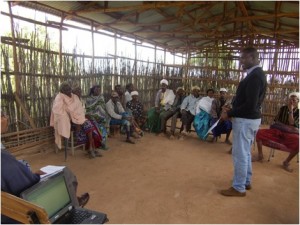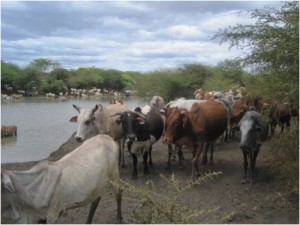Reducing the Vulnerability of Kenya’s Pastoralists to Drought with Livestock Insurance

Pastoralists gather to learn about the index-based livestock insurance from insurance agents and researchers.
In the arid and semi-arid lands of northern Kenya, pastoralists’ livelihoods depend on the health of their herds. In anticipation of drought, households often avoid potentially high-return activities for safer strategies, keeping them poorer than they need to be. When drought hits, they can lose their livestock, and consequently, the bulk of their household assets. During and after a drought with its associated livestock mortality, many cash-strapped households sell their remaining livestock. This strategy drives down livestock prices, damaging their ability to recover. To break this cycle, pastoralists need to be able to meet their immediate financial needs without selling off their livestock and to pursue more productive coping strategies.
In January 2010, the BASIS collaborative research program I4 Index Insurance Innovation Initiative researchers from Cornell, the University of California, Davis, Australian National University, Syracuse University, and the International Livestock Research Institute (ILRI) launched a pilot livestock insurance product with the hope that it will help pastoralists in the Marsabit District to manage drought risk. For areas like northern Kenya, where the costs of verifying specific household losses are too great to be commercially viable, index insurance offers an alternative by basing payouts on an index that is correlated with predicted average losses. Index-based livestock insurance (IBLI) uses satellite-based measures of vegetative cover to predict average livestock mortality experienced in local communities. Insured households will receive a payout when the predicted average livestock mortality rate reaches 15 percent. The expectation is that with an anticipated payout if livestock mortality rises, households will pursue more productive strategies than they would otherwise and avoid selling off their assets (i.e., livestock).
The 2011 drought triggered the payment of the first index-based livestock insurance indemnities on the continent. On average, households lost more than a third of their herds. At the time of the payout, participants were asked how to predict how they would cope with the aftermath of the drought for the coming three months. Compared to uninsured households, insured households are less likely to reduce the number of meals eaten, less likely to sell livestock, and less likely to rely on food aid. Asked how they would spend the payout, households indicated that depending on the size of the payout they would use it differently. For a smaller payout, households anticipated spending much of it on food. For  larger payouts, households anticipated purchasing livestock or investing in other savings. This latter finding is particularly important since it suggests that insured households move from being net sellers of livestock to net buyers, which can have positive spillover effects on uninsured households. Regardless of the size of the payout, on average, households expected to spend 10 percent of it to purchase the insurance again.
larger payouts, households anticipated purchasing livestock or investing in other savings. This latter finding is particularly important since it suggests that insured households move from being net sellers of livestock to net buyers, which can have positive spillover effects on uninsured households. Regardless of the size of the payout, on average, households expected to spend 10 percent of it to purchase the insurance again.
The IBLI project will undergo additional impact evaluation to understand further effects of the insurance and ascertain whether the beneficial effects of the insurance are large enough to justify investment in similar insurance products. A similar pilot has also now been launched in Ethiopia.
